
Hornblende is a complex inosilicate series of minerals. It is not a recognized mineral in its own right, but the name is used as a general or field term, to refer to a dark amphibole. Hornblende minerals are common in igneous and metamorphic rocks.

Rhodochrosite is a manganese carbonate mineral with chemical composition MnCO3. In its pure form (rare), it is typically a rose-red colour, but it can also be shades of pink to pale brown. It streaks white, and its Mohs hardness varies between 3.5 and 4.5. Its specific gravity is between 3.45 and 3.6. It crystallizes in the trigonal system, and cleaves with rhombohedral carbonate cleavage in three directions. The crystal structure of rhodochrosite is a rhombohedral system, which is a subset of the trigonal system. The carbonate ions (CO3) are arranged in a triangular planar configuration, and the manganese ions (Mn) are surrounded by six oxygen ions in an octahedral arrangement. The MnO6 octahedra and CO3 triangles are linked together to form a three-dimensional structure. Crystal twinning often is present. It is often confused with the manganese silicate, rhodonite, but is distinctly softer. Rhodochrosite is formed by the oxidation of manganese ore, and is found in South Africa, China, and the Americas. It is officially listed as one of the National symbols of Argentina.

Psilomelane is a group name for hard black manganese oxides including hollandite and romanechite. Psilomelane consists of hydrous manganese oxide with variable amounts of barium and potassium. Psilomelane is erroneously, and uncommonly, known as black hematite, despite not being related to true hematite, which is an iron oxide.

Pyrolusite is a mineral consisting essentially of manganese dioxide (MnO2) and is important as an ore of manganese. It is a black, amorphous appearing mineral, often with a granular, fibrous, or columnar structure, sometimes forming reniform crusts. It has a metallic luster, a black or bluish-black streak, and readily soils the fingers. The specific gravity is about 4.8. Its name is from the Greek for fire and to wash, in reference to its use as a way to remove tints from glass.
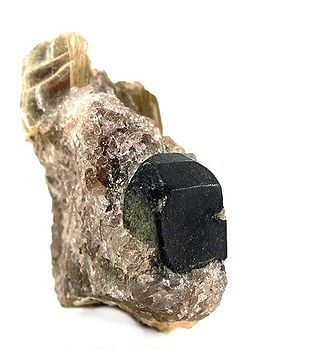
Triphylite is a lithium iron(II) phosphate mineral with the chemical formula LiFePO4. It is a member of the triphylite group and forms a complete solid solution series with the lithium manganese(II) phosphate, lithiophilite. Triphylite crystallizes in the orthorhombic crystal system. It rarely forms prismatic crystals and is more frequently found in hypidiomorphic rock. It is bluish- to greenish-gray in color, but upon alteration becomes brown to black.
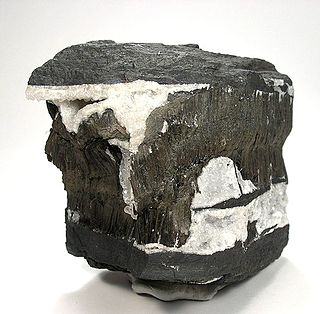
Todorokite is a complex hydrous manganese oxide mineral with generic chemical formula (Na,Ca,K,Ba,Sr)
1-x(Mn,Mg,Al)
6O
12·3-4H
2O. It was named in 1934 for the type locality, the Todoroki mine, Hokkaido, Japan. It belongs to the prismatic class 2/m of the monoclinic crystal system, but the angle β between the a and c axes is close to 90°, making it seem orthorhombic. It is a brown to black mineral which occurs in massive or tuberose forms. It is quite soft with a Mohs hardness of 1.5, and a specific gravity of 3.49 - 3.82. It is a component of deep ocean basin manganese nodules.

Nsutite is a manganese oxide mineral with formula: (Mn4+1−xMn2+xO2-2x(OH)2x where x = 0.06-0.07). It is found in most large manganese deposits and was first discovered in Nsuta, Ghana. Since then, it has been found worldwide. Nsutite is a dull mineral with a hardness of 6.5-8.5 and an average specific gravity of 4.45. Nustite is used as a cathode in zinc–carbon batteries, but synthetic manganese oxide is gradually replacing it.
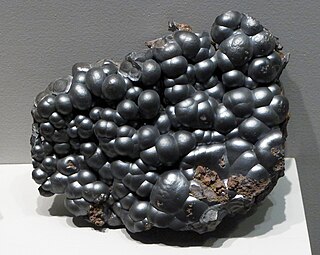
Romanèchite ((Ba,H2O)2(Mn4+,Mn3+)5O10) is the primary constituent of psilomelane, which is a mixture of minerals. Most psilomelane is not pure romanechite, so it is incorrect to consider them synonyms. Romanèchite is a valuable ore of manganese, which is used in steelmaking and sodium battery production. It has a monoclinic crystal structure, a hardness of 6 and a specific gravity of 4.7-5. Romanèchite's structure consists of 2 × 3 tunnels formed by MnO6 octahedra.

Birnessite (nominally MnO2·nH2O), also known as δ-MnO2, is a hydrous manganese dioxide mineral with a chemical formula of Na0.7Ca0.3Mn7O14·2.8H2O. It is the main manganese mineral species at the Earth's surface, and commonly occurs as fine-grained, poorly crystallized aggregates in soils, sediments, grain and rock coatings (e.g., desert varnish), and marine ferromanganese nodules and crusts. It was discovered at Birness, Aberdeenshire, Scotland.

Jacobsite is a manganese iron oxide mineral. It is in the spinel group and forms a solid solution series with magnetite. The chemical formula is (Mn,Mg)Fe2O4 or with oxidation states and substitutions: (Mn2+,Fe2+,Mg)(Fe3+,Mn3+)2O4.
Akhtenskite is a manganese oxide mineral with the chemical formula of MnO2 (or: ε-Mn4+O2) that was named after the Akhtensk deposit in Russia, where it was first discovered and noted in 1979. It can be found in the Akhtensk brown ironstone deposit, in the southern Ural Mountains, on Mt. Zarod, on the Sikhote-Alin Mountains, and in the Primorskiy Krai, all in Russia.
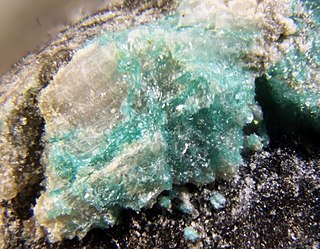
Campigliaite is a copper and manganese sulfate mineral with a chemical formula of Cu4Mn(SO4)2(OH)6·4H2O. It has a chemical formula and also a crystal structure similar to niedermayrite, with Cd(II) cation replacing by Mn(II). The formation of campigliaite is related to the oxidation of sulfide minerals to form sulfate solutions with ilvaite associated with the presence of manganese. Campigliaite is a rare secondary mineral formed when metallic sulfide skarn deposits are oxidized. While there are several related associations, there is no abundant source for this mineral due to its rare process of formation. Based on its crystallographic data and chemical formula, campigliaite is placed in the devillite group and considered the manganese analogue of devillite. Campigliaite belongs to the copper oxysalt minerals as well followed by the subgroup M=M-T sheets. The infinite sheet structures that campigliaite has are characterized by strongly bonded polyhedral sheets, which are linked in the third dimension by weaker hydrogen bonds.
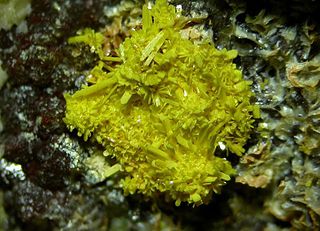
Bergenite is a rare uranyl phosphate of the more specific phosphuranylite group. The phosphuranylite-type sheet in bergenite is a new isomer of the group, with the uranyl phosphate tetrahedra varying in an up-up-down, same-same-opposite (uuduudSSOSSO) orientation. All bergenite samples have been found in old mine dump sites. Uranyl minerals are a large constituent of uranium deposits.
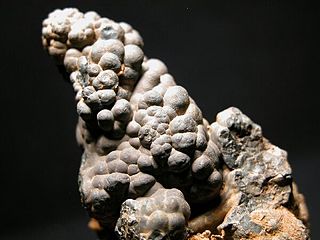
Cryptomelane (K(Mn4+,Mn2+)8O16) is the potassium endmember of the hollandite group, a family of tectomanganates with a 2 x 2 tunnel structure.
Bobfergusonite is a mineral with formula Na2Mn5FeAl(PO4)6. The mineral varies in color from green-brown to red-brown. It was discovered in 1986 in Manitoba, Canada, and named for Robert Bury Ferguson (born 1920). As of 2012, the mineral has only been found in Canada and Argentina.
Filipstadite is a very rare mineral of the spinel group, with the formula (Mn,Mg)(Sb5+0.5Fe3+0.5)O4. It is isometric, although it was previously though to be orthorhombic. When compared to a typical spinel, both the octahedral and tetrahedral sites are split due to cation ordering. Filipstadite is chemically close to melanostibite. The mineral comes from Långban, Sweden, a manganese skarn deposit famous for many rare minerals.
Fluorcarmoite-(BaNa) is a rare phosphate mineral, belonging to arrojadite group, with the formula Ba[]Na2Na2[]CaMg13Al(PO4)11(PO3OH)F2. It is a barium-rich member of the group, as is arrojadite-(BaNa), arrojadite-(BaFe), fluorarrojadite-(BaFe) and an unapproved species ferri-arrojadite-(BaNa). The "-(BaNa)" suffix informs about the dominance of the particular elements (here barium and sodium) at the corresponding structural sites.

Ramsdellite (Mn4+O2) is an orthorhombic manganese dioxide mineral. It is relatively uncommon, and is usually found in deposits containing other manganese oxide crystals.
Buserite is a hydrated layered manganese-oxide mineral with nominal chemical formula MnO2·nH2O. It was named after Swiss chemist professor W. Buser, who first identified it in 1952 in deep-sea manganese nodules. Buser named it 10 Å manganate because the periodicity in the layer stacking direction was 10 Å. It was renamed buserite in 1970 by the nomenclature commission of the International Mineralogical Association (IMA).
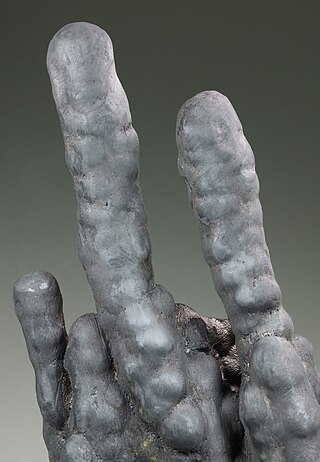
Coronadite is the lead endmember of the hollandite group, a family of tectomanganates with a 2 x 2 tunnel structure. The mineral was named after Francisco Vasquez de Coronado who was an explorer of southwest USA. The name was made up by Waldemar Lindgren in 1905.

















